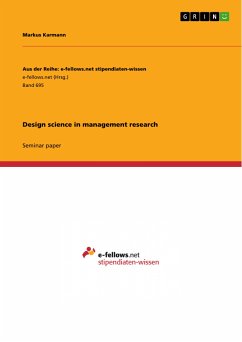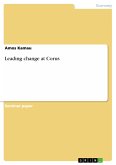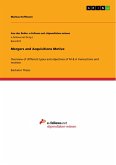Seminar paper from the year 2013 in the subject Business economics - Business Management, Corporate Governance, grade: 1,0, European School of Business Reutlingen, language: English, abstract: Management research is constantly criticized in the academic community to have very little impact on managers in practical life. This problem is highly discussed in academic circles and often referred to as the utilization problem (van Aken, 2004) or the rigor-relevance dilemma/gap (Fincham & Clark, 2009; Avenier, 2010). The problem is that the conducted management research is either scientifically verified, but not relevant for practice or practically relevant but not scientifically verified (van Aken, 2004). There are various explanations for this problem. Many researchers claim that a lack of sufficient communication presentation of management research is the root of the problem (Davies, 2007). This is in accordance with the so-called "knowledge transfer problem"(Shapiro, Kirkman, & Courtey, 2007). Others blame the little relevance of management research for practitioners (Denyer, Tranfield, & van Aken, 2007), which is reflected in the "knowledge production problem" (Shapiro, Kirkman, & Courtey, 2007). Furthermore, management research is claimed as "too descriptive" (van Aken, 2004), which means that management science is only describing and analyzing but not actually providing solutions to problems. Lastly, some researchers describe management research as too fragmented in terms of research groups and knowledge products (Denyer, Tranfield, & van Aken, 2007). The researchers claim that too little cooperation between researchers restricts knowledge solutions and weakens the position of management research. In order to increase relevance of management research and to create a clear academic identity (Tranfield & van Aken, 2006) academic community calls for new research approaches, particularly the so-called design science approach (van Aken, 2004). Design science helps to actually design solutions to field problems but still keeping academic relevance in order to fulfill Pettigrew's idea of accomplishing both, academic and practical relevance (Pettigrew, 1997). This paper aims to give the reader an overview on design science and its (possible) practical relevance in management research. First of all, the author will present the ideas of design science and its main determinants of major research contributors. Afterwards, a comparison between design science and the often with design science presented action research and evidence-based management approach is made. Chapter 3 will then present two examples of executed research and applied design science.
Dieser Download kann aus rechtlichen Gründen nur mit Rechnungsadresse in A, B, BG, CY, CZ, D, DK, EW, E, FIN, F, GR, HR, H, IRL, I, LT, L, LR, M, NL, PL, P, R, S, SLO, SK ausgeliefert werden.









